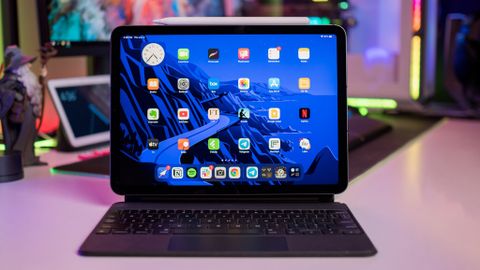Android Central Verdict
With a premium design that's identical to the iPad Pro and a vibrant 10.9-inch screen, the iPad Air nails the basics. The internal hardware has picked up a big boost thanks to the custom M1 silicon, and there's 5G connectivity here. You also get a new 12MP camera at the front that changes viewing angles automatically to ensure you're always in focus during video calls, and iPadOS 15.5 has an app ecosystem that is unrivaled on Android. Best of all, the iPad Air 2022 connects over USB-C, and it will get at least five OS updates in the future.
Pros
- +
M1 silicon delivers incredible power
- +
Cellular model gets 5G connectivity
- +
Vibrant 10.9-inch screen
- +
Charges over USB-C
- +
Will get at least five platform updates
- +
Extensive app ecosystem
Cons
- -
Screen still at 60Hz
- -
Not an OLED panel
Why you can trust Android Central
If you're looking to pick up a tablet, an iPad has always been the go-to recommendation. With Google fumbling its tablet strategy and most device makers pulling out of the category, there just weren't many Android tablets that could measure up to the iPad.
Samsung was the outlier here; its Galaxy Tab S series continues to be the only decent option if you want a high-end Android tablet, and while Samsung added a lot of custom features to scale One UI to a tablet layout, it couldn't do much about third-party apps.
This situation is finally changing, as Google has once again signified interest in tablets. Android 12L gives much-needed attention to tablets, and Google is even making its own Pixel Tablet — although that isn't launching until 2023. In the meantime, the likes of OPPO, Xiaomi, and other Chinese brands are introducing new tablets to cater to the budget and mid-range tiers, and of course Samsung continues to make the best Android tablets.
That said, the shadow of the iPad looms large in this segment, and this year's iPad Air in particular is a strong showing. Apple didn't change too much against the iPad Air 2020, but it didn't have to — that was already one of the best overall tablets available, and by updating the internals with the insanely powerful M1 and adding 5G connectivity, the iPad Air M1 is differentiated enough that it can stand on its own.
Yes, Android tablets are about to get much better. But if you want something right now, the iPad Air M1 is already great.
Apple iPad Air M1: Availability

Apple launched the iPad Air M1 on March 8, and the tablet is now available globally. It is sold in two variants — Wi-Fi and Cellular — and available in two storage sizes. The base 64GB model with Wi-Fi starts off at $599, and the 256GB model retails for $749. If you need cellular connectivity, you'll need to pay $749 for the 64GB model and $899 for the 256GB version.
Here's the breakdown of the variants and what they cost around the world:
- iPad Air M1 (64GB/Wi-Fi): $599 / £569 / €679 / ₹54,900
- iPad Air M1 (256GB/Wi-Fi): $749 / £719 / €849 / ₹68,900
- iPad Air M1 (64GB/Wi-Fi + Cellular): $749 / £719 / €849 / ₹68,900
- iPad Air M1 (256GB/Wi-Fi + Cellular): $899 / £869 / €1,019 / ₹82,900
For context, the 11-inch iPad Pro starts off at $799 for the 128GB version, so the iPad Air M1 costs $200 less while featuring the same M1 silicon. Of course, you miss out on a few features, but we'll get to that further below.
Apple iPad Air M1: Design and screen

Visually, there's no difference between the iPad Air M1 and its predecessor, the iPad Air 2020. Both tablets have the same design aesthetic with flat sides, which is similar to what you'll find on the iPad Pro as well. Touch ID is baked into the power button, and with a weight of 1.02 pounds (462 grams), it isn't too heavy or unwieldy in daily use — even with a case.
The iPad Air M1 has the same design and dimensions as its predecessor — you can use cases designed for the iPad Air 2020 here.
On that note, as the physical dimensions (247.6 x 178.5 x 6.1mm) aren't different between the iPad Air M1 and its predecessor, you'll be able to use cases designed for the iPad Air 2020 here.
I was able to slot in the Magic Keyboard that I got with the iPad Air 2020 and use it with the M1 model without any issues whatsoever. Apple introduced new folio cases with the iPad Air M1, but you can save some cash and just pick up cases made for the iPad Air 2020.








As for colors, there are five options this time: Grey, Blue, Pink, Starlight, and Purple. Although the design itself hasn't changed, the iPad Air M1 feels just as premium as the iPad Pro. The aluminum chassis is great to hold, and the thin bezels around the screen maximize screen real estate. Touch ID does a good job with authentication, and while it isn't as seamless as Face ID, it is fast and reliable.
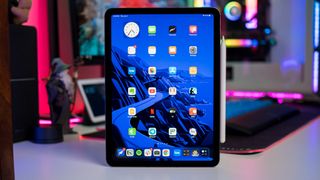
The screen is also unchanged here, and you get the same 10.9-inch IPS LCD panel as the iPad Air 2020. It has True Tone tech, P3 color gamut, and an anti-glare coating that's useful for when you're outdoors, and like its predecessor, it is limited to 60Hz. Like the iPhone 13 series, the 120Hz option is limited to the Pro models, and that isn't likely to change anytime soon.
That said, the Liquid Retina LCD panel has vibrant colors and excellent contrast levels, and it holds up very well in daily use. I would have liked to see 120Hz here, but that would have cannibalized the iPad Pro, so it's understandable why that feature isn't available here.
Apple iPad Air M1: Performance
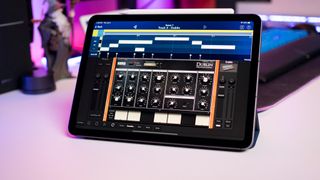
The biggest upgrade for the iPad Air M1 comes in the form of internal hardware. While its predecessor featured the A14 Bionic, the latest-gen iPad Air is powered by the octa-core M1, and it unlocks a whole new level of power.
That isn't to say that the A14 Bionic is outdated or doesn't pass muster in 2022 — far from it. It's just that the M1 has much more headroom for the future. As for what it's like right now, I didn't see any issues in the two months I used it.
This is the same design that powers the MacBook Air, and whether it's running video editing utilities or music production software, the M1 did not break a sweat.
With the iPad Air also running M1 silicon, it is on an equal footing with the iPad Pro in this particular area. Another feature that made its way to the tablet is the 12MP selfie camera that automatically switches viewing angles, so you're always in the center of the frame during FaceTime or Zoom calls.

That said, the Pro model has a few differentiating factors, including the 120Hz refresh I mentioned above. You also get better cameras and a Lidar camera at the back, better onboard sound, Face ID, and a Thunderbolt 4 connector. While the iPad Air also has a USB-C port, it's a standard USB 3.1 Gen2 connector without Thunderbolt.
Elsewhere, you get the same Wi-Fi 6 and Bluetooth 5.0 connectivity as the iPad Air 2020, and I didn't have any issues connecting to my home Wi-Fi and getting a reliable signal.
If you're interested in the cellular model, you'll be glad to know that the iPad Air M1 has 5G connectivity, but like the iPhone SE 2022, it is limited to Sub-6 bands and not the faster mmWave bands like the iPhone 13.
Battery size is also identical between generations, and I managed to get roughly the same amount of battery longevity as the iPad Air 2020.

As for accessories, the Magic Keyboard is absurdly costly, but it is a wonderful addition if you're looking for a keyboard accessory for the iPad Air. It securely holds the tablet, the keys have decent travel, and the smooth hinge allows you to tilt the iPad Air to a comfortable position.

In a similar vein, the Apple Pencil is great if you want to use the iPad Air for digital sketching, painting, or just doodling. Powerful utilities like Procreate let you unlock the full potential of the stylus, but if you're like me and want to use it for something a little more fun, Lake is a digital coloring app that is highly engaging.
Apple iPad Air M1: Software
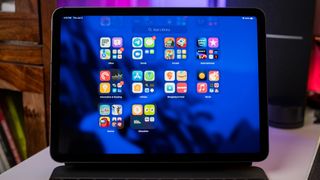
iPadOS 14 introduced a lot of meaningful additions like hand-written note recognition and dynamic widgets. The iPadOS 15 builds on that with App Library, Focus mode, and a new Notification Center that shows relevant notifications over the course of the day. A new multitasking menu easily lets you switch to Split View or a Slide Over floating window.
I used the iPad Air M1 for over two months now, and like its predecessor, it is inherently versatile. We got an exercise bike earlier this year, and as it doesn't have a screen of its own, I slotted in the iPad Air M1 to play guided workouts and connect to the bike over Bluetooth. The iPad Air is also a fantastic device for browsing, and I use it most of the time to read longform articles and scroll through Reddit.

Thanks to stereo sound, it holds up particularly well for playing videos. It gets sufficiently loud that I don't usually connect a Bluetooth speaker while streaming YouTube or football games, and the stereo speakers also make a difference while gaming.
On that note, I only used the folio case when streaming videos, and the rest of the time, I used the iPad Air without any case. It didn't take any tumble in the two months I used it, but I didn't notice any scratches or other signs of wear on the product, and I use it a lot over the course of the day.
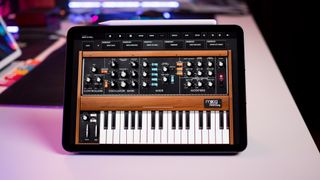
My favorite use case for the iPad Air M1 is music production. iPadOS has an extensive library of apps tailored for music production, and the iPad is particularly useful as a portable device for creating ideas on the go.
With the switch to M1 silicon, the iPad Air handles intensive DAW (digital audio workstation) utilities like the Korg Gadget without breaking a sweat. Combine that with the fact that you'll find plenty of synth instruments, drum machines, grooveboxes, and other plugins on the App Store, and the iPad becomes a powerful machine for music production.
Finally, the iPad Air M1 will pick up five years of platform updates as standard. So even if you don't intend to use the same iPad for that long, it should hold its value better.
Apple iPad Air M1: The competition

If you don't care about 5G connectivity and the beefier internal hardware, the iPad Air 2020 is still a stellar choice in 2022. It has the same design, screen, and battery, and connects to the same set of accessories. The A14 Bionic has a lot to offer, so even if you're looking to play demanding games or use it for image editing, it has plenty to offer.
Need a larger screen or an OLED panel? You'll need to take a look at the iPad Pro. The 12.9-inch variant has a gorgeous OLED screen that goes up to 120Hz, and it has all the extras you don't get with the iPad Air M1.
Apple iPad Air M1: Should you buy it?
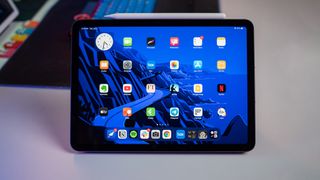
You should buy this if:
- You want an iPad with the best price-to-performance figures.
- You need an iPad with a premium design and thin bezels.
- You want 5G connectivity.
- You need a tablet with an extensive app ecosystem.
You shouldn't buy this if:
- You want an iPad with a 120Hz screen.
- You need an OLED panel.
With the move to M1 silicon, the iPad Air becomes the best deal in Apple's tablet portfolio. You're getting the same level of performance as the iPad Pro for $200 less, and while it misses out on Face ID, quad speakers, Thunderbolt 4 connectivity, and a Lidar camera, those aren't huge omissions. The only difference I see between the two models that would make me want to upgrade is the 120Hz option on the Pro.
But if you don't care about that, the iPad Air M1 is the default choice if you're interested in buying a new tablet in 2022. It costs $270 more than the regular iPad, but you're getting an extensive set of features here, including USB-C charging, stereo sound, a more vibrant screen, and a sleeker design with thinner bezels. And of course, the fact that it's running the M1 alone makes the iPad Air worth the recommendation.

The iPad Air M1 uses the same design as its predecessor, but it gets significantly faster hardware in the form of the M1 silicon. You also get 5G, excellent battery life, great software with meaningful additions and five years of updates, and a vibrant screen. In short, this is the best iPad to buy in 2022.

Harish Jonnalagadda is a Senior Editor overseeing Asia at Android Central. He leads the site's coverage of Chinese phone brands, contributing to reviews, features, and buying guides. He also writes about storage servers, audio products, and the semiconductor industry. Contact him on Twitter at @chunkynerd.
